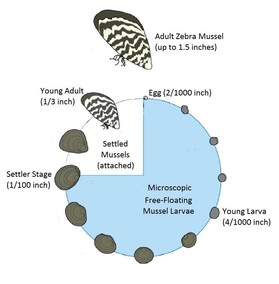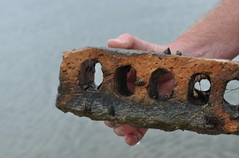|
|
|
|
 Once zebra mussel eggs are fertilized they become microscopic larvae that float freely in the water for up to a month. Because these larvae are invisible to the naked eye, boaters must drain all water between lakes to prevent their transportation in residual water in live wells, bait buckets, ballast tanks, and bilges.
As zebra mussels mature into adults, the larvae become settlers at a size of only 1/100th of an inch and start to attach to hard surfaces, but are hard to see. Using tiny, root-like fibers called byssal threads, the young settlers bond to boats, docks, floats, rocks, plants, pipes, and any other hard surface or crevice in the water.
Zebra mussels grow rapidly to a maximum shell size of about 1.5 inches and can reach densities of more than 700,000 individuals per square yard. They heavily impact hydroelectric facilities and other infrastructure located in or drawing water from infested waters. Although zebra mussels live for only 1.5 to 2 years in Texas, they can start reproducing within the first year of life at about 1/3 inch long. Please encourage tenants to call our 24/7 hotline at (512) 389-4848 to ask for guidance before a boat is moved from a marina on a lake with zebra mussels!
|
We’ve developed a flyer you can use to help let marina slip tenants know about zebra mussels and steps to help them deal with and prevent moving mussels. Download the zebra mussel tenant awareness flyer — and provide them to new and existing tenants, especially when they give notice that they’re going to be ending their lease!
 We’re inviting all marinas on lakes without zebra mussels to help us keep an eye out for zebra mussels in Texas lakes. It is very simple and inexpensive to participate – all you need is a rope and a brick.
Tie one end of the rope to the brick and the other end to a dock and make sure the rope is long enough that the brick hangs at least 6 feet deep (or just above the bottom in shallow water). Pull the brick out of the water about once a month to check for zebra mussels. It is a good idea to run your hand along the brick to feel for small shells. Zebra mussels are hard to see when they’re young. Over time the brick will look dirty, but that’s a good thing! You want the brick to grow a layer of algae or ‘biofilm,’ which is attractive to settling zebra mussels.
If you find zebra mussels or anything suspicious on your sampler, text photos and the location to (512) 552-3465 (anytime!) or email the info to aquaticinvasives@tpwd.texas.gov.
|

TPWD Zebra Mussel Contacts
Coordination on Infested Boats:
|
|
|
|
|